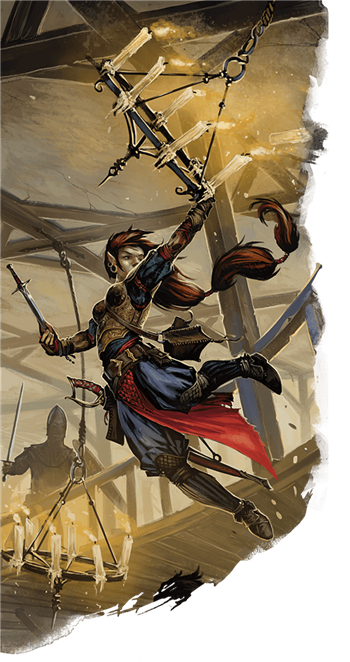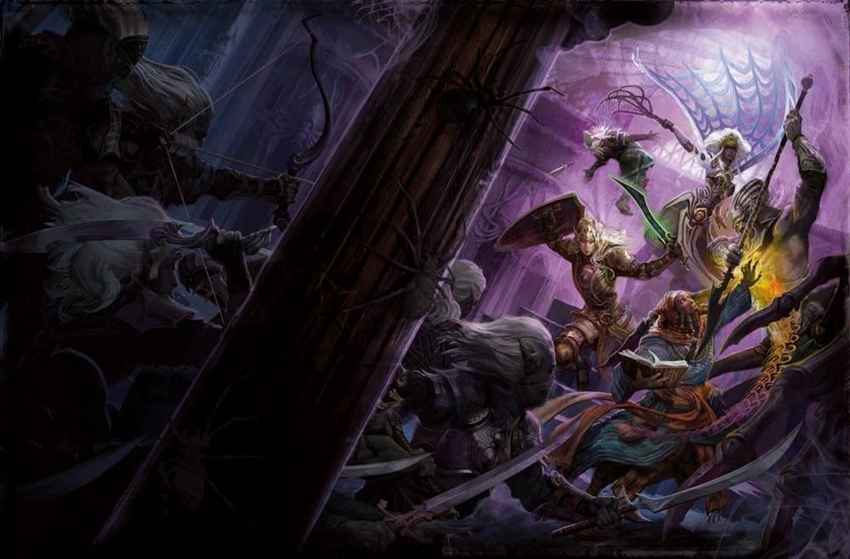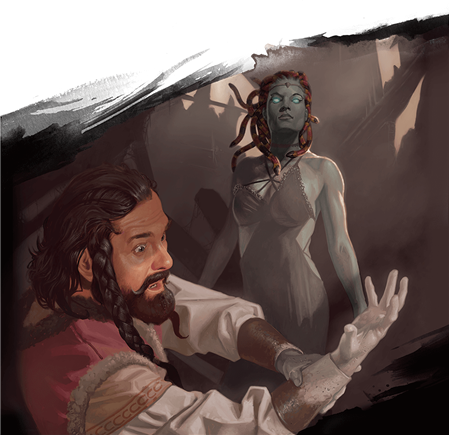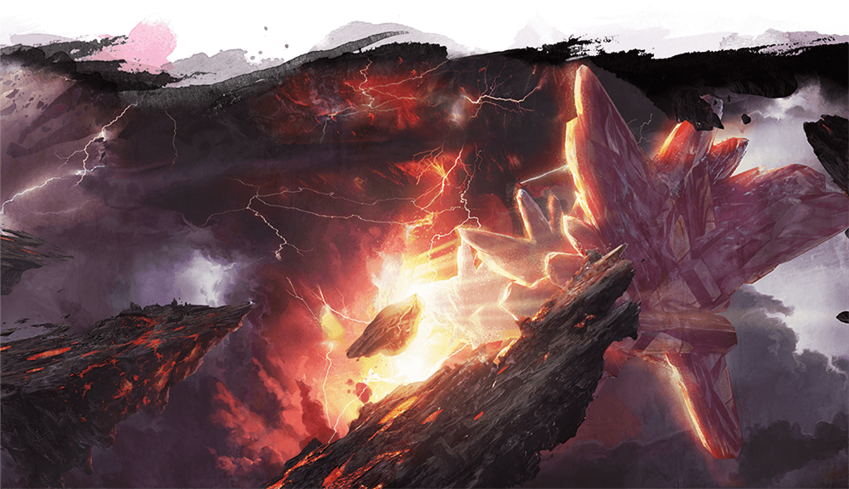 When most D&D players think about the game, they think about their characters first, since those characters are their way into the game: both the lenses through which they see the game, but also the chisels that allow them to sculpt their parts of the campaign’s narrative. Next, players might think about the overall campaign: what they have achieved, what is in their immediate future, and what may happen down the road. They might even think about adventures: some goals they achieved and enemy they defeated.
When most D&D players think about the game, they think about their characters first, since those characters are their way into the game: both the lenses through which they see the game, but also the chisels that allow them to sculpt their parts of the campaign’s narrative. Next, players might think about the overall campaign: what they have achieved, what is in their immediate future, and what may happen down the road. They might even think about adventures: some goals they achieved and enemy they defeated.
Rarely do players think in terms of encounters (unless something goes terribly wrong, of course). Yet, for adventure designers, encounters are the most important element of the game. If encounters don’t sing (be they combat encounters, social encounters, or otherwise), the careful worldbuilding, story planning, and overarching plots are for naught. The encounter is where the players, and their characters, interact with the campaign most significantly. Often, we designers build grand worlds and imagine grand stories, but we fail at the most crucial point: the design of the specific moment where the characters meet our grand creations.
As we build adventures, sessions, stories, campaigns, worlds, or whatever aspect you want to name, the encounter is the smallest complete building block we have at our disposal. As we build the mosaic that will become our adventure, encounters are the colorful pieces we lay down. We must make absolutely sure they are the right size, shape, color, and texture to fit nicely into our overall work of art.
During our outlining, we come up with a list of possible encounters that lead the characters from the start to the end of the adventure. Now we just need to create those encounters.
So, What’s an Encounter?
As I design adventures, I think of encounters as discrete and self-contained processes, because encounters contain their own elements, their own challenges, their own stories, and their own range of outcomes. After we create that encounter, we shove into it unknown variables: most importantly among them, the players bring their characters, those characters’ motivations and desires, and their knowledge of the story so far.
As the characters enter an encounter-process, they should know what’s at stake and what their goals are—or they should learn what’s at stake and what their goals are at some point during the encounter. Somewhere along the line, the characters are tested as they pursue those goals, or they make decisions that affect the outcome, or both. Then, based on the choices—and the successes or failures, not to mention the luck of the dice—they emerge from the process-encounter different from how they entered. The next step in their journey then begins. That next encounter might be obvious based on their new knowledge and goals, or they might have more choices to make. Regardless of the route they take via their choices and their successes or failures, the characters move on to the next encounter, with their new goals and their new information.
If we know what an encounter is, we can then figure out what needs to go into an encounter on the most basic level, and then we can delve deeper into the different types of encounters, and the different ways we can set one up. Again, this is where many adventure designers run into problems. It’s much more fun to think about worldbuilding and storytelling, about grand plots and incredible characters, when the hard work on an adventure, where the characters are actually experiencing the game and its narrative, is really done on the encounter level. Do the hard work, and you (and most importantly, the players) will reap the rewards.

If You Build It…
Based on the description above, we can begin to pinpoint the necessary components of and considerations for any encounter, whether it is strictly roleplaying, strictly exploration, strictly combat, or a combination of any of those three:
- Known Information
- Learned Information
- Goals
- NPCs
- Threats/Challenges
- Setting
- Choices
- Location and Purpose in Adventure
Let’s look at these individually:
Known Information
What the characters know going into an encounter can be vital to the entire encounter they’re about the play. The more truthful and detailed the information they have, the easier it should be for them to plan for and execute the encounter.
If you’ve DMed for any significant amount of time, you know the lengths to which some players go to learn everything about the encounter they’re about to face. Characters facing a dragon want to know not just the color of the dragon to prepare for a specific type of breath weapon, but they want to know what the lair looks like, any traps in the area, other creatures they might encounter, etc. These attempts to learn information about an impending encounter might, of course, become encounters of their own, with their own challenges to overcome, NPCs to interact with, areas to explore, and choices to make.
So what we’re talking about is keeping track of that known information as we create the impending encounters. What information did we give out already? How might that information be used? And the most important question of all: was that information true, false, incomplete, or irrelevant? How can we create the encounter to reward, to subvert, to highlight, or to complicate the encounter based on that information?
There is drama and tension in the dissonance between the information known at the start of the encounter and the information learned once the encounter starts. Overused, that tactic can quickly turn to annoyance. Use it sparingly and to its greatest effect. If the characters go into every encounter knowing everything they’re going to face, it becomes too much of a crutch and can be boring. By that same logic, if they go into every encounter with no knowledge, or always with inaccurate knowledge, that repetition is unhealthy to the game as well.
Learned Information
As the characters move through the encounter, they probably learn more information that helps them make decisions within the encounter. This information might be new, might confirm previously gathered information, or could show the characters that the information they received previously was incomplete or incorrect.
Most information processing is going to be handled immediately when the encounter starts, probably in the form of boxed text or some other vehicle of information delivery. (Setting, NPCs, monsters, and other immediate challenges or threats comprise the obvious information, but we’ll talk about those later.) The information I am referring to are details that might be hidden or obscured, but that are important for completing the encounter. Or more importantly, it’s information they might need as they conclude the encounter, in order to continue on their path through the adventure.
Whatever information the characters need or we feel we must provide, it’s crucial to remember this: don’t hide that information. We might be tempted to make the characters work for the information, and that can be fun and challenging and satisfying for them—but more often than not it’s just frustrating.
For example, let’s say that there’s an altar in the evil temple that absorbs radiant damage when the undead near it are targeted with radiant effects. This is a neat wrinkle to add to an encounter. First draw attention to the altar in the opening description. Describe the dark energy emanating from it, and how that energy washes over the zombies standing near it. This should trigger a player to inquire further. If they do, call for an Intelligence (Arcana or Religion) check at a reasonable DC. If the check succeeds, describe the effect in clear, game-mechanical terms.
If they don’t catch the hint in the description, describe it again the first time the altar absorbs radiant damage. The same check should provide the details—maybe even give advantage on the check because the characters witnessed the effect. At some point it may be necessary to just flat out tell them after a set number of rounds, especially if the effect is drastically changing the difficulty of the encounter. And that’s OK.
One last point about disseminating information: don’t make it a bonus action or a reaction for characters to gain information (or do other things in an encounter) via ability checks. Bonus actions and reactions are game elements specific to certain class abilities, spells, or other rules. Either make it an action if it is something that is highly involved, or make it no action at all if it is just recalling a bit of information or noticing something.
Goals
The reason to have an encounter is because the characters are trying to do something, or possibly several things. It’s generally assumed that “survival” is always a goal, so we don’t even need to mention that. (Of course, one might imagine encounters where survival is not the goal, we can set that aside for now too.) Like other information, the goal of the players in the encounter should be clear going in, or should become clear as the encounter plays itself out. Changing goals in the middle of an encounter is sometimes fun, but again, that can lead to problems or frustration if it happens too often.
Varying goals for encounters from one to the next, on the other hand, is a great tool for making great encounters and great adventures. Not every combat should be about simply killing all the monsters. Not every roleplaying encounter should be just persuading and getting information. Not every exploration encounter need be simply finding the trap and disarming it.
And more importantly, not every encounter goal needs to tie directly into the goal of the adventure—although you do want every goal to take the story of the adventure forward in new and exciting ways. Even if an adventure seems like a straight-forward, hack n’ slash dungeon crawl, the goal of one encounter might be to help the friendly deep gnome find the tastiest mushrooms for his soup, because only he has the key that gets them through the door they need to pass. Such changes of pace are welcomed in an adventure. (When we talk about using the pillars of D&D in encounter design, we’ll talk about this topic further.)
NPCs
These are the enemies, allies, and neutral parties whom the characters interact with during an encounter; however, I prefer to think of NPCs as anything that the characters might talk to. An animated statue that the characters have to convince to open the door to a haunted temple is an NPC to me. Like all the other elements of encounters we’ve talked about, varying NPCs—and using them in new and different ways within an encounter—can surprise and delight your players.
 It’s important to give your NPCs personalities, quirks, flaws, and motivations of their own that are relevant to the encounter. These elements are just as important to bringing an NPC to life in an encounter as are the details, like the size and shape, of a room during combats. The parameters of an NPC-focused encounter hinge on what they want and how they act or react in the presence of the characters.
It’s important to give your NPCs personalities, quirks, flaws, and motivations of their own that are relevant to the encounter. These elements are just as important to bringing an NPC to life in an encounter as are the details, like the size and shape, of a room during combats. The parameters of an NPC-focused encounter hinge on what they want and how they act or react in the presence of the characters.
One tip for NPCs and encounters: reuse NPCs as much as possible while still having the encounter and the adventure make sense. Always keep an eye on NPCs you’ve used previously in encounters, and see if they can make a curtain call, in a new light if possible. The brigand who escaped in the first encounter might be the information provider in the fifth encounter, and the previous interactions can inform what happens in the new encounter. The decisions characters made previously, and the information they gathered, help (or hinder) in the new encounter.
Threats/Challenges
The threats and challenges of an encounter are, simply put, the things that stand between the characters and their goals. The most obvious threats during most encounters are the slavering monsters that oppose the characters. This is a foundation of the game, and it behooves us to remember that this is what brings many players to the game. That doesn’t mean every encounter needs to be about overcoming that particular type of threat; it’s just important to remember that getting too far away from the threat of monsters killing them can leave a significant number of players dissatisfied.
That said, most players are going to appreciate wide variety of threats and challenges, whether or not deadly monsters are involved. Similarly, not every challenge needs to have life or death as the final stakes. Ask a player whose character has a very powerful magic item if they would rather lose their character or the magic item, and you might be surprised at the answer (or you might not). The challenge of completing a ritual dance at a royal social gathering without stepping on anyone’s toes might be as tense and as memorable as fighting the demon lord.
Setting
Where an encounter takes place, and the details you use to describe the setting, are important for immersion, but they could have ramifications across the entire encounter. Will the setting make the challenge harder or easier for the characters? Can the characters affect the setting in a way that changes aspects of the encounter? Or maybe the NPCs or monsters can change the setting as well unless the characters stop them?
The most important thing to remember with setting is how the area and its components might affect the characters as they attempt to deal with the challenges. Focus on what is relevant, downplay what is not, and keep the characters focused on the details they need.
Choices
It is certainly possible that an encounter may not have any specific threat or challenge, or the goal may be as simple as making a choice. After recovering magical crown from the orc’s lair, the characters have to decide whom they should give it to. This is a decision worthy of an encounter, but it may not have all the elements of a combat or exploration encounter. That’s OK! But like other encounters, make sure they players have all the information they need, and provide those elements that make the encounter more interesting and evocative.

Location and Purpose within Adventure
Our adventure might have two or three encounters, or it could have 50 encounters. Regardless of the number of encounters, we have to pay careful attention to where our encounter falls within the adventure, what the purpose of the encounter is, and how difficult the encounter might be for the characters to complete and meet their goals.
On the mechanical level in its capacity as a resource management game, part of the tension and drama of D&D is the narrative progress versus the game-mechanical realties. When a party is low on hit points, out of spells, and tapped of their most useful or powerful resources—yet the story encourages them to push forward or face dire narrative consequences—you are inspiring some of the best moments that D&D (and storytelling in general) has to offer. You must also be careful not to overdo that, pushing the characters into a hopelessly impossible position.
Short rests and long rests are a tool not just for the players. They should be considered in each and every encounter. Does this encounter provide an opportunity for a rest? If so, what are the benefits and drawbacks of a party taking either type of rest? Both as a designer of a game and a facilitator of a story, what makes the most sense, and what can be changed to make the game or the story (and hopefully both) more interesting?
Build Upon Sturdy Pillars
In the next article, we’ll continue our look at designing encounters for our adventure with special attention to the three pillars of D&D: combat, exploration, and roleplaying. Then we’ll design one or two encounters in our adventure!
What kind of encounters do you like to design? What's difficult for you? Let us know in the comments.
 Shawn Merwin's professional design, development, and editing work in D&D has spanned 20 years and over 4 million words of content, ranging from third to fifth edition. His most recent credits include the Acquisitions Incorporated book, Baldur’s Gate: Descent into Avernus, and Storm Lord’s Wrath. He is also the Resource Manager for the D&D Adventurers League’s Eberron: Oracle of War campaign. Shawn hosts a weekly D&D podcast called Down with D&D, and he holds an MFA in Creative Writing from Vermont College of Fine Arts. You can follow his ramblings and musing on Twitter at @shawnmerwin.
Shawn Merwin's professional design, development, and editing work in D&D has spanned 20 years and over 4 million words of content, ranging from third to fifth edition. His most recent credits include the Acquisitions Incorporated book, Baldur’s Gate: Descent into Avernus, and Storm Lord’s Wrath. He is also the Resource Manager for the D&D Adventurers League’s Eberron: Oracle of War campaign. Shawn hosts a weekly D&D podcast called Down with D&D, and he holds an MFA in Creative Writing from Vermont College of Fine Arts. You can follow his ramblings and musing on Twitter at @shawnmerwin.
Want to read more of this series? Click on the "Let's Design an Adventure!" tag to see the full series.








-
View User Profile
-
Send Message
Posted Dec 4, 2019Great article, as usual!
You should do an article on managing a group of players, keeping them in line, feeding them information realistically, and most importantly, making sure they have fun.
Thanks!
-
View User Profile
-
Send Message
Posted Dec 4, 2019Sometimes these articles are revelations that change how I think about the game. For once it's nice to read an article that confirms how I think about the game and creating interesting encounters.
-
View User Profile
-
Send Message
Posted Dec 4, 2019Another excellent article. :)
-
View User Profile
-
Send Message
Posted Dec 5, 2019This is a great article with lots of practical actionable advice.
Thanks for sharing!
-
View User Profile
-
Send Message
Posted Dec 5, 2019Great article, it is going to go a long way in enriching the encounters I prepare.
Personally I enjoy combat encounters that have a bit of verbal interaction where the antagonist/s have some intelligence.
Where I struggle is the description or the verbal narrative of the encounter. It is not enough to step through the turns with only dice rolls, but it is hard to try and describe every round - perhaps not every round needs to be described - maybe only the the more significant encounters that add more to the overall narrative need the extra flashy words.
Either way I need to build a repertoire of words and descriptions for when the players are not narrating their characters in the battle.
-
View User Profile
-
Send Message
Posted Dec 5, 2019This was an OK article, but it was kind of hard for me to follow. If a singular encounter was broken down into these 8 components, it would have really helped bring all the points home.
-
View User Profile
-
Send Message
Posted Dec 5, 2019I do an 80/20 guideline. 80% of the time, I describe rolls in pure mechanical terms (zombie hits you for 5 bludgeoning damage. Those who fail a DC 12 dexterity saving throw take 14 damage while this who succeed take 7.). The other 20% has done flavor to it (the zombie clobbers you with a haymaker for 5 bludgeoning damage. The banshee wails a harrowing scream; Make a wisdom saving throw.).
This is about right to get creativity in while not exhausting yourself and your party with dialogue as long as a final fantasy game.
-
View User Profile
-
Send Message
Posted Dec 5, 2019Yes, I have tried to be clear from the start that this series will hopefully be useful to everyone, but it is looking at adventure design from the perspective of someone who writes adventures that need to be playable by any players and useful to any DMs.
-
View User Profile
-
Send Message
Posted Dec 5, 2019Amazing article. I'm currently writing an own adventure and really using this advices. Thank you so much.
PS: Sad though that those articles are not coming out in a more regular und especially faster rhythm, cause I start the adventure in two weeks und really want and love to integrate more of those amazing tipps from your articles.
-
View User Profile
-
Send Message
Posted Dec 5, 2019This remains the best series of articles ever run on DnDB.
I like to design encounters that give the players choices that they can look back on as game changers. “I could really use my ____ right now. I wish I hadn’t traded it to that merchant for this sword.” Or “You realize we’re buying these potions with the reward money for turning in that thief from the wanted poster. I wonder if there really was a treasure he’d have shared with us for letting him go free.”
I wish I knew what was difficult for me. I don’t really get to playtest any of my ideas. Some of the things I think are so brilliant in my head may be complete duds if an average party were encountering them. I’m hoping that changes next year and I can DM with some regularity. Then I’ll likely have plenty of failures to define what’s difficult for me.
-
View User Profile
-
Send Message
Posted Dec 5, 2019Man, I hope that for you, too. Im DMing for one and a half year now every first or second week. I' really trying to give my players those game changer moments. But for having those work out for you it is important to know what your players are free to do. I so often tried to put in some amazing moments but they won't play out as I wanted. I had to learn that some choices in the mind of a DM aren't even choices in the minds of some players. I always had the problem, that some of my players never really cared about game changing moments with loot, cause they never really tied any of the ,lot to their characters and just treated it like they were in a video game. This makes it hard for me to bring in game changers with loot for example.
Your players have to be into some sort of role-play and character development in the course of a campaign. On such occasion it is possible to make such game changer experiences work for the DM and the Players both. So get the interests of your layers right away before writing an adventure. Cause, sad though, the adventure can be as great as possible, it only comes to live if the players want that type of greatness you are giving them. If informed about your players it is such fun to design encounters that directly respond to those characteristics they want to play and desires they have when being a player. A great foundation for amazing sessions.
-
View User Profile
-
Send Message
Posted Dec 5, 2019One tip i picked up, and have tried to do in-game as I DM. Might not go to your overarching stuff, ubt anice way of getting flow in the combat aswell as some descriptive narration;
Try to what the rest of the monsterds/NPCs/environment is doing after each players turn. Lets say the fihter swings wildly at an orc, everyone can imagine that as the player more or less describes it. Instead, when switching to the next players turn, describe what the other monsters are doing, "As teh fighter cleaves the orc, you see the three orcs in the back start to string their bows". It can give the players a more immideate feel of whats going on, aswell as act on what they see around. Sure, you might be giving away that those three orcs intend to fire their bows at the fighter, but then the next player can actually act on a monster that feels more alive.
I feel it also helps players prepare their rounds, as they wont spend so much time thinking about what other monsters are going to do, and they might even feel some pressure as the battlefield is in motion at all times.
-
View User Profile
-
Send Message
Posted Dec 5, 2019This is an amazing article that helped me a lot. Thank you!
-
View User Profile
-
Send Message
Posted Dec 6, 2019This is great information.
-
View User Profile
-
Send Message
Posted Dec 8, 2019I love this series of articles and am excited for each one. They have added a lot to my design style and influence when crafting. I have been a DM for ages now, (since 2e), and still love getting new info and tips as the game grows and develops it's player base. The Critical Role effect is real, and it has led both me and my players to new experiences in our D&D group, and tips like these help all of us work together to have a great game filled with better encounters, better characters, and deeper understanding of what we are all doing together at the table.
-
View User Profile
-
Send Message
Posted Dec 9, 2019Yes! These articles are amazing, and once you're done with this "Building an Adventure" segment, you should do an article on actually running that/an adventure - at least, it would be highly appreciated
-
View User Profile
-
Send Message
Posted Dec 9, 2019I like that! The previous session of the game I'm DMing left off at the start of a combat encounter, so we'll be diving right in next time and it will be a perfect time to test this out. I've been looking for a way to include more tension and story to combat encounters, and I think this will be perfect rather than the dull waiting-for-the-orcs-turn-to-come-around-to-know-anything, which feel unnatural to me. Thanks for the tip!
-
View User Profile
-
Send Message
Posted Dec 10, 2019Amazing article! Future Dungeon Masters will create challenges against the players for sure!
-
View User Profile
-
Send Message
Posted Dec 12, 2019This is one of the best articles on DNDBeyond yet. I will certainly review this when designing encounters for my upcoming campaign.
-
View User Profile
-
Send Message
Posted Dec 15, 2019I really enjoyed this article. I'm new to being a DM. This has helped me plan the next segment in our campaign. Thank you.